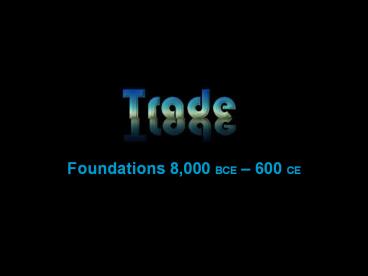Foundations 8,000 BCE - PowerPoint PPT Presentation
Title:
Foundations 8,000 BCE
Description:
Foundations 8,000 BCE 600 CE – PowerPoint PPT presentation
Number of Views:91
Avg rating:3.0/5.0
Title: Foundations 8,000 BCE
1
- Foundations 8,000 BCE 600 CE
2
(No Transcript)
3
- Trade evident even at the hunter-gatherer level
- Evidence of boats used for river/sea trade
- Catal Huyuk prospered from obsidian trade
- Trade based on barter
Catal Huyuk
4
(No Transcript)
5
- Mesopotamia
- Had to import timber, metals, and stone from as
far away as India - Downriver traffic only- boats dismantled and wood
sold - Boats used for heavy loads such as grain
- Land routes used for lighter and more precious
loads - Invention of wheel allowed greater loads
6
- Trade initially under control of royalty/priests
but devolved to merchant class over time - Cuneiform developed to record business
transactions - Barter or silver used as means of exchange until
introduction of coins after sixth century BCE - Conquest used as a means to secure resources
Scribes record the amount of goods
7
- Hittites
- semi-control of metals including iron due to
ownership of mineral deposits
Kingdom of the Hittites
8
- Phoenicians
- Major maritime trade state
- Established trade colonies throughout
Mediterranean and Black seas - First to use polar star for navigation
- Acted as trucking company for major states
Phoenicians trading with Egyptians
9
(No Transcript)
10
- Egypt
- Extensive trade with Mesopotamia, the Minoans,
and indirectly with India - Strong interest in Nubia and trade with south and
central Africa - Imported raw resources, slaves, gold, and
aromatic resins for mummification
Egyptian trade routes
11
- Nubia (Kush)
- Acted as intermediary between Egypt and Africa in
trade - Possessed natural resources (gold)
- Slave trade
Kushite pharaoh
12
- Geographic shift towards Meroe
- Meroe culture moved away from Egyptian influences
towards sub-Saharan - Economy collapsed after Rome shifted trade to Red
Sea and Axum (Ethiopia)
Iron-making in Meroe
13
- The Indus (Harappa)
- Widespread trade contacts in east and west
Mesopotamia and possibly China - Access to rich metal ores more metal tools than
Mesopotamia and Egypt - Seals may be the names of merchants
Harappan Seal
14
- Shang China
- Despite isolation, trade contacts with India and
Central Asia - Some evidence of contact with Mesopotamia
- Large use of bronze emphasis on trade routes
for copper and tin
Shang bronze vessel
15
(No Transcript)
16
- Greece
- Natural harbors and islands made sea travel
fastest and cheapest mode of trade - Lack of natural resources such as metals and
timber and lack of arable lands made trade vital - Success or failure in trade impacted the rise and
fall of civilizations
The coastline of Greece
17
- Minoans
- Major maritime trade state
- Trade contacts with all of Mediterranean and
Middle East - Spread Egyptian and Persian ideas to Mycenaeans
and later Greek societies - Linear A possibly used to record lists of goods
and other business transactions
The Minoans
18
- Mycenaeans
- Linear B used to record lists of goods and
business transactions - State control of key industries including wool
production - Supplanted Minoans as regional transporters
- Metals in great demand gold for rulers and
copper/tin for bronze
19
- Mycenaeans both traders and pirates preyed on
weak states - Conflict with Troy and Hittites over control of
trade in the Aegean and Back Seas
20
(No Transcript)
21
- Carthage
- Established as a colony by Phoenicians
- Maritime trade power dominated the western
Mediterranean - Economic policies focused on protection of sea
lanes and securing natural resources - Some evidence of trade w/sub-Saharan Africa and
British Isles
City of Carthage
22
- Greek City-States
- Colonies established to
- Act as bases for trade
- Relieve population pressures
- Provide food for mother city-state
- Sparta
- To emphasize equality Spartans banned precious
metals and coins - Spartans forbidden to engage in commerce
Spartan hoplites
23
- Athens
- Size of Athenian navy allowed Athens to project
power to enhance commercial interests - Transformation of Delian League into trade
association - Commercial estates wine and oil exports
An Athenian Trireme
24
- Hellenistic Civilizations
- Greek culture widespread based on empire of
Alexander the Great - Alexandria nexus of Mediterranean and Indian
Ocean trade (via Red Sea)
Hellenic Trade Routes
25
- Rome
- Central location positive impact on trade
- Territorial expansion brought in revenue and
surplus goods from new provinces - Roman provincial towns drew in artisans and
merchants from all over
Busy Roman port
26
- The Roman military spurred trade in the provinces
- Pax Romana era of peace and prosperity
- Major import was gain to feed poor
Poor Romans crowd the busy streets
27
(No Transcript)
28
Roman grain trade
29
Roman Mediterranean trade
30
Roman eastern trade
31
(No Transcript)
32
(No Transcript)
33
- China
- Encouraged technological innovation
- Construction of roads and canals stimulated trade
- Development of the Silk Road
- Silk exports
- Merchant class held in low esteem
34
- India
- Due to absence of strong rule (political
fragmentation), merchant guilds became very
powerful - Trade contacts with China and Roman Empire
- Decline of Rome resulted in increased trade with
SE Asia and China export of Indian culture
Hindu temples Angkor Wat, Cambodia
35
- Changes
- Move from barter to coins as system of exchange
- Greater interaction between civilizations
direct links between Rome and China - Cultural diffusion through trade spread of
religion, architecture, disease - Decline in trade in Europe after fall of Rome
36
- Continuities
- Dominance of India and China in trade
- Chinas demand for silver
- The Silk Road and Indian Ocean trade routes
- Constantinople as western trade hub































